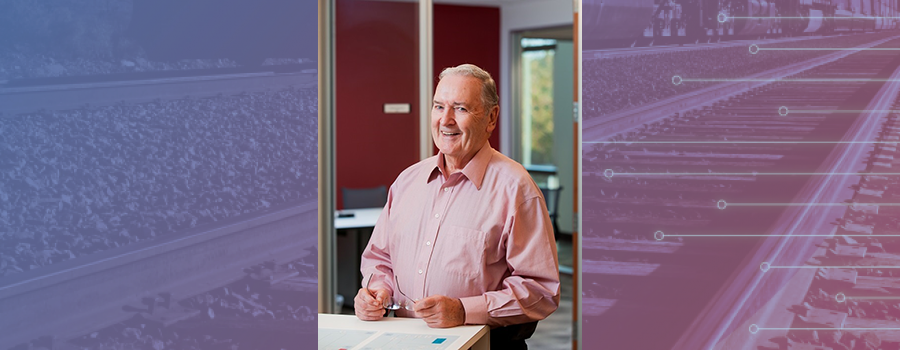
When Jim Moran started his railroad career in 1958 as a clerk in the machine room of the Pennsylvania Railroad, the industry had not yet embraced data processing. A discipline like car hire—the calculating and disbursing of the compensation paid for the use of a railcar—wasn't done through sophisticated technology systems like the ones Railinc manages today.
"If you could have seen what we did with car hire," Moran said. "It was unbelievable how anyone got paid."
Today, the car hire process is much smoother thanks to innovative ideas, powerful technologies and dedicated people like Moran.
On Oct. 31, Moran retired from Railinc after 57 years of service to the freight rail industry.
A Leader in Railroad Technology
Moran has been a leader at the Association of American Railroads (AAR) and Railinc in the development and advancement of essential technology tools that have contributed greatly to the ongoing safety, efficiency and ultimate success of the freight rail system. Moran, who retired as director of AAR support services, was central to the development of the Umler® system and its adoption as the keystone industry repository for critical rail data.
Today, the entire freight rail industry uses the system "Mr. Umler" helped to develop. The data contained within it are essential to a wide range of railroad operations and form the foundation for many Railinc applications.
"Jim has always been stalwart in his work ethic and unwavering in his support for our company and our industry," said Allen West, Railinc president and CEO. "His knowledge of railroad operations and his drive to improve the underlying processes and technologies have helped to make the industry safer and more efficient. His work has made lasting changes to how the industry operates."
Impact Visible Across the Industry
Moran joined the AAR in 1967 and came to Railinc in 1998, when the AAR spun out the company as a subsidiary. The impact of his work is visible in operations across the industry, from car hire to asset health to the circulars that support rules all railroads must follow. He helped to create the Early Warning System, which enables the rail industry to identify mechanical problems on railcars that could affect the safe movement of freight.
It's the Umler system, though, that has returned inestimable value to the freight rail industry—no measure simply captures its success. His work in the development and growth of the original Universal Machine Language Equipment Register (U.M.L.E.R.) and through its evolution into the current Umler system transformed railroad technology and communications.
From the early punch card mainframe to the table-driven database with millions of data points, Moran guided the industry in the most critical of paths, providing information for building and routing trains across North America and shepherding the rail industry into the information age.
"If a car isn't correctly registered in Umler, it doesn't move off your property," Moran said. "It is work registering cars, but the ultimate gain is having the information in there correctly. In this world, you can't live with mediocrity. If you don't report the right length on car in Umler, you can destroy a train."
Teaching, Learning, Making the Industry Better
Beyond the technology, Moran's greatest impact remains upon the people he worked with over the years. The strong relationships he developed with industry representatives and Railinc customers and coworkers reflect the respect they have for him and for the care he brought to his work.
"Jim was dedicated to his job and the industry, and his name would always pop up when I'd go to industry committee meetings," said John Kozlowski, a Railinc business analyst. "From car owners to roads, everybody has worked with Jim. And they always have good things to say, that he has been a benefit to the industry."
He always had an ear to listen and a good word to offer to anyone seeking his advice, wisdom and counsel into understanding how and why the rail system works and how to get the most out of the technology.
"Jim’s understanding of the rail industry and the foundational elements of its technology is without equal," said Anthony Will, a senior technical writer. "He always made time to answer any questions I had, and his solutions combined the best of common sense with keen business acumen."
For Moran, learning was always central to his work and was one reason he stayed in it so long. The industry is always changing, he said, and if you don't learn something every day, you aren't doing your job.
"It's the challenge," Moran said, "not only to learn new things, but of picking up a process and asking, 'Is that the best we can do this? How can we make this better?'"
By doing just that, Moran helped make the industry better.
—Railinc Corporate Communications
